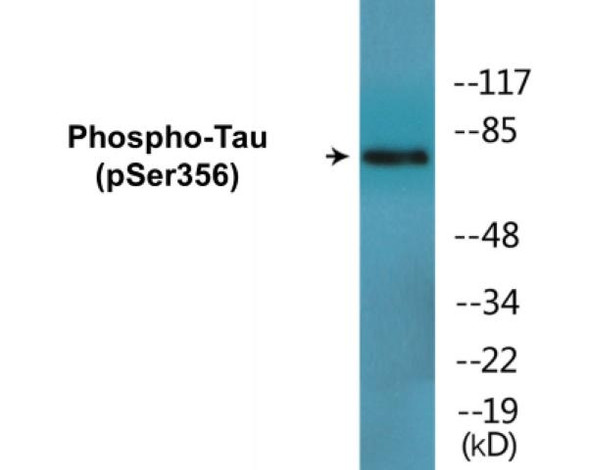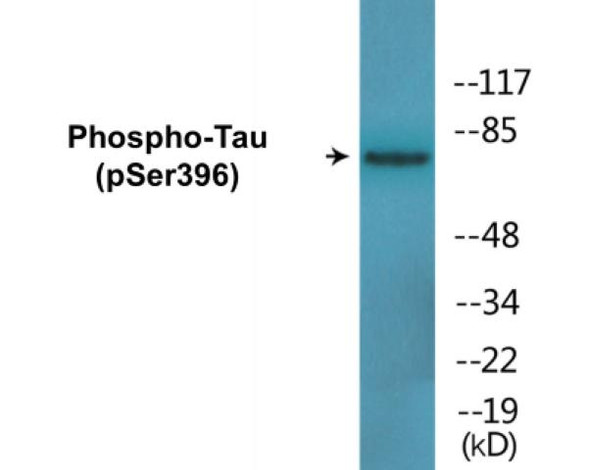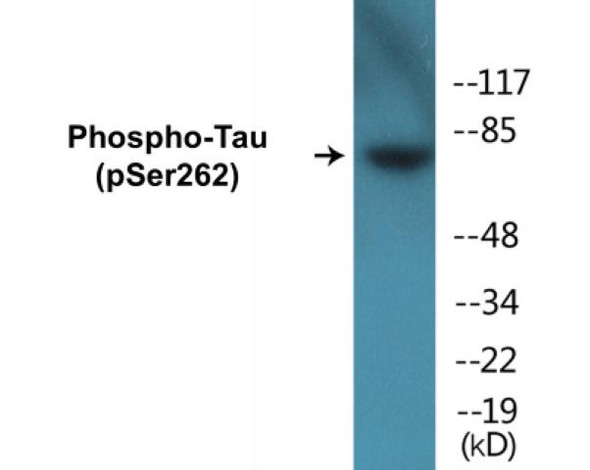Description
Tau (Phospho-Thr534/217)Colorimetric Cell-Based ELISA Kit
The Tau Phospho-Thr534/217 Colorimetric Cell-Based ELISA Kit is a powerful tool for researchers looking to accurately detect and quantify levels of phosphorylated tau protein in cell lysates. This kit offers high sensitivity and specificity, allowing for reliable and reproducible results in a variety of experimental settings.Phosphorylated tau protein is a key player in the development of neurodegenerative diseases, such as Alzheimer's disease, making it a valuable target for studying disease progression and developing potential therapeutic interventions. By using this ELISA kit, researchers can gain important insights into the role of phosphorylated tau in disease pathogenesis, paving the way for new treatment strategies.
Overall, the Tau Phospho-Thr534/217 Colorimetric Cell-Based ELISA Kit is an essential tool for researchers investigating the mechanisms of neurodegenerative diseases and seeking to identify novel therapeutic targets. With its high sensitivity and specificity, this kit offers a reliable method for detecting phosphorylated tau protein and advancing our understanding of neurodegenerative disorders.
| Product Name: | Tau (Phospho-Thr534/217) Colorimetric Cell-Based ELISA |
| Product Code: | CBCAB01637 |
| ELISA Type: | Cell-Based |
| Target: | Tau (Phospho-Thr534/217) |
| Reactivity: | Human, Mouse, Rat |
| Dynamic Range: | > 5000 Cells |
| Detection Method: | Colorimetric 450 nm |
| Format: | 2 x 96-Well Microplates |
The Tau (Phospho-Thr534/217) Colorimetric Cell-Based ELISA Kit is a convenient, lysate-free, high throughput and sensitive assay kit that can detect Tau protein phosphorylation and expression profile in cells. The kit can be used for measuring the relative amounts of phosphorylated Tau in cultured cells as well as screening for the effects that various treatments, inhibitors (ie. siRNA or chemicals), or activators have on Tau phosphorylation.
Qualitative determination of Tau (Phospho-Thr534/217) concentration is achieved by an indirect ELISA format. In essence, Tau (Phospho-Thr534/217) is captured by Tau (Phospho-Thr534/217)-specific primary (1ø) antibodies while the HRP-conjugated secondary (2ø) antibodies bind the Fc region of the 1ø antibody. Through this binding, the HRP enzyme conjugated to the 2ø antibody can catalyze a colorimetric reaction upon substrate addition. Due to the qualitative nature of the Cell-Based ELISA, multiple normalization methods are needed:
| 1. | A monoclonal antibody specific for human GAPDH is included to serve as an internal positive control in normalizing the target absorbance values. |
| 2. | Following the colorimetric measurement of HRP activity via substrate addition, the Crystal Violet whole-cell staining method may be used to determine cell density. After staining, the results can be analysed by normalizing the absorbance values to cell amounts, by which the plating difference can be adjusted. |
| Database Information: | Gene ID: 4137, UniProt ID: P10636, OMIM: 157140/172700/260540/600274/601104/607485, Unigene: Hs.101174 |
| Gene Symbol: | MAPT |
| Sub Type: | Phospho |
| UniProt Protein Function: | Tau: a microtubule-associated protein that regulates microtubule assembly and stability. Apparently involved in the establishment and maintenance of neuronal polarity. Mutations can result in several neurodegenerative disorders such as Alzheimer's disease, Pick's disease, frontotemporal dementia, cortico-basal degeneration and progressive supranuclear palsy. The C-terminus binds axonal microtubules while the N-terminus binds neural plasma membrane components, suggesting that tau functions as a linker. Axonal polarity is predetermined by tau localization (in the neuronal cell) in the domain of the cell body defined by the centrosome. Nine differentially spliced isoforms have been described. The short isoforms allow plasticity of the cytoskeleton, whereas the longer isoforms may preferentially play a role in its stabilization. |
| UniProt Protein Details: | Protein type:Cytoskeletal Chromosomal Location of Human Ortholog: 17q21.1 Cellular Component: microtubule; microtubule associated complex; growth cone; axon; tubulin complex; plasma membrane; axoneme; cytosol Molecular Function:protein binding; enzyme binding; structural constituent of cytoskeleton; microtubule binding; apolipoprotein binding; protein kinase binding; SH3 domain binding Biological Process: axon extension; apoptosis; positive regulation of microtubule polymerization; positive regulation of axon extension; axon cargo transport; neuron migration; microtubule cytoskeleton organization and biogenesis; adult walking behavior; regulation of microtubule polymerization; mitochondrion transport along microtubule; negative regulation of intracellular transport; generation of neurons; regulation of autophagy; cell structure disassembly during apoptosis Disease: Supranuclear Palsy, Progressive, 1; Pick Disease Of Brain; Frontotemporal Dementia; Parkinson-dementia Syndrome; Parkinson Disease, Late-onset; Frontotemporal Lobar Degeneration With Tdp43 Inclusions, Grn-related |
| NCBI Summary: | This gene encodes the microtubule-associated protein tau (MAPT) whose transcript undergoes complex, regulated alternative splicing, giving rise to several mRNA species. MAPT transcripts are differentially expressed in the nervous system, depending on stage of neuronal maturation and neuron type. MAPT gene mutations have been associated with several neurodegenerative disorders such as Alzheimer's disease, Pick's disease, frontotemporal dementia, cortico-basal degeneration and progressive supranuclear palsy. [provided by RefSeq, Jul 2008] |
| UniProt Code: | P10636 |
| NCBI GenInfo Identifier: | 6754638 |
| NCBI Gene ID: | 4137 |
| NCBI Accession: | NP_005901 |
| UniProt Related Accession: | P10636 |
| Molecular Weight: | 46kDa |
| NCBI Full Name: | microtubule-associated protein tau isoform 2 |
| NCBI Synonym Full Names: | microtubule associated protein tau |
| NCBI Official Symbol: | MAPT |
| NCBI Official Synonym Symbols: | TAU; MSTD; PPND; DDPAC; MAPTL; MTBT1; MTBT2; FTDP-17; PPP1R103 |
| NCBI Protein Information: | microtubule-associated protein tau |
| UniProt Protein Name: | Microtubule-associated protein tau |
| UniProt Synonym Protein Names: | Neurofibrillary tangle protein; Paired helical filament-tau |
| Protein Family: | Tautomerase |
| UniProt Gene Name: | MAPT |
| UniProt Entry Name: | TAU_HUMAN |
| Component | Quantity |
| 96-Well Cell Culture Clear-Bottom Microplate | 2 plates |
| 10X TBS | 24 mL |
| Quenching Buffer | 24 mL |
| Blocking Buffer | 50 mL |
| 15X Wash Buffer | 50 mL |
| Primary Antibody Diluent | 12 mL |
| 100x Anti-Phospho Target Antibody | 60 µL |
| 100x Anti-Target Antibody | 60 µL |
| Anti-GAPDH Antibody | 60 µL |
| HRP-Conjugated Anti-Rabbit IgG Antibody | 12 mL |
| HRP-Conjugated Anti-Mouse IgG Antibody | 12 mL |
| SDS Solution | 12 mL |
| Stop Solution | 24 mL |
| Ready-to-Use Substrate | 12 mL |
| Crystal Violet Solution | 12 mL |
| Adhesive Plate Seals | 2 seals |
The following materials and/or equipment are NOT provided in this kit but are necessary to successfully conduct the experiment:
- Microplate reader able to measure absorbance at 450 nm and/or 595 nm for Crystal Violet Cell Staining (Optional)
- Micropipettes with capability of measuring volumes ranging from 1 µL to 1 ml
- 37% formaldehyde (Sigma Cat# F-8775) or formaldehyde from other sources
- Squirt bottle, manifold dispenser, multichannel pipette reservoir or automated microplate washer
- Graph paper or computer software capable of generating or displaying logarithmic functions
- Absorbent papers or vacuum aspirator
- Test tubes or microfuge tubes capable of storing ≥1 ml
- Poly-L-Lysine (Sigma Cat# P4832 for suspension cells)
- Orbital shaker (optional)
- Deionized or sterile water
*Note: Protocols are specific to each batch/lot. For the correct instructions please follow the protocol included in your kit.
| Step | Procedure |
| 1. | Seed 200 µL of 20,000 adherent cells in culture medium in each well of a 96-well plate. The plates included in the kit are sterile and treated for cell culture. For suspension cells and loosely attached cells, coat the plates with 100 µL of 10 µg/ml Poly-L-Lysine (not included) to each well of a 96-well plate for 30 minutes at 37 °C prior to adding cells. |
| 2. | Incubate the cells for overnight at 37 °C, 5% CO2. |
| 3. | Treat the cells as desired. |
| 4. | Remove the cell culture medium and rinse with 200 µL of 1x TBS, twice. |
| 5. | Fix the cells by incubating with 100 µL of Fixing Solution for 20 minutes at room temperature. The 4% formaldehyde is used for adherent cells and 8% formaldehyde is used for suspension cells and loosely attached cells. |
| 6. | Remove the Fixing Solution and wash the plate 3 times with 200 µL 1x Wash Buffer for five minutes each time with gentle shaking on the orbital shaker. The plate can be stored at 4 °C for a week. |
| 7. | Add 100 µL of Quenching Buffer and incubate for 20 minutes at room temperature. |
| 8. | Wash the plate 3 times with 1x Wash Buffer for 5 minutes each time. |
| 9. | Add 200 µL of Blocking Buffer and incubate for 1 hour at room temperature. |
| 10. | Wash 3 times with 200 µL of 1x Wash Buffer for 5 minutes each time. |
| 11. | Add 50 µL of 1x primary antibodies Anti-Tau (Phospho-Thr534/217) Antibody, Anti-Tau Antibody and/or Anti-GAPDH Antibody) to the corresponding wells, cover with Parafilm and incubate for 16 hours (overnight) at 4 °C. If the target expression is known to be high, incubate for 2 hours at room temperature. |
| 12. | Wash 3 times with 200 µL of 1x Wash Buffer for 5 minutes each time. |
| 13. | Add 50 µL of 1x secondary antibodies (HRP-Conjugated AntiRabbit IgG Antibody or HRP-Conjugated Anti-Mouse IgG Antibody) to corresponding wells and incubate for 1.5 hours at room temperature. |
| 14. | Wash 3 times with 200 µL of 1x Wash Buffer for 5 minutes each time. |
| 15. | Add 50 µL of Ready-to-Use Substrate to each well and incubate for 30 minutes at room temperature in the dark. |
| 16. | Add 50 µL of Stop Solution to each well and read OD at 450 nm immediately using the microplate reader. |
(Additional Crystal Violet staining may be performed if desired – details of this may be found in the kit technical manual.)






